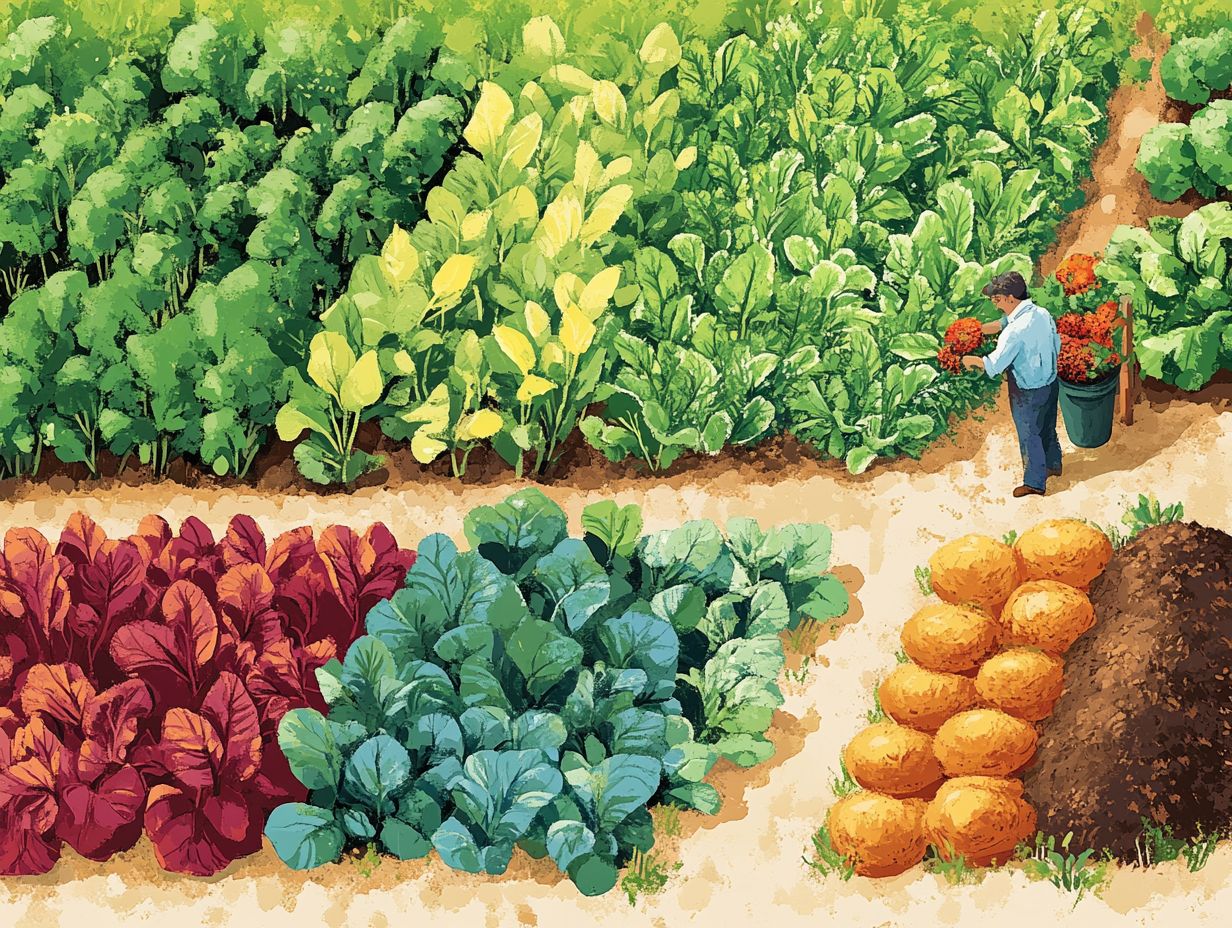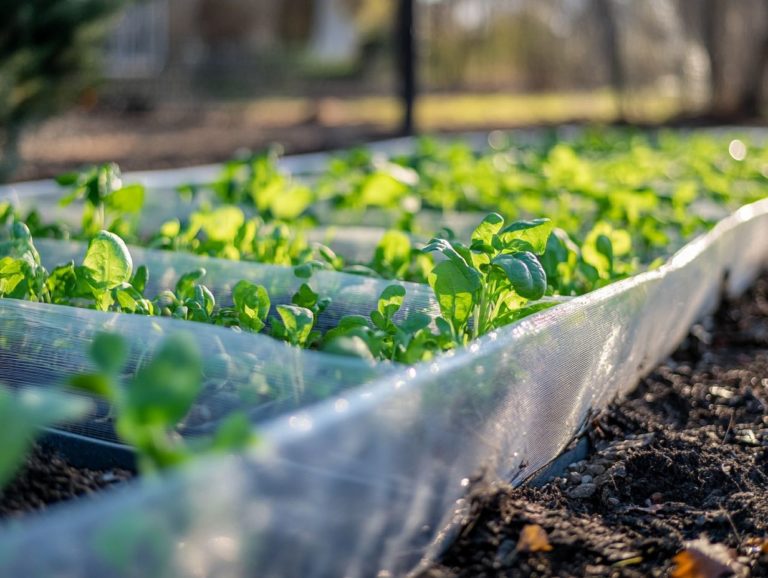Using Seasonal Rotation to Manage Pests
Get ready to explore seasonal rotation your garden’s health will thank you!
Seasonal rotation is an effective strategy to enhance your garden’s health while managing pests with finesse. By varying the types of plants you grow in a specific area each season, you can significantly minimize pest populations and lessen your dependence on chemical pesticides.
This guide highlights the advantages of seasonal rotation for pest management and offers practical steps for implementation, including working with nature to control pests.
You’ll discover various seasonal rotation plans tailored to different environmental conditions, along with additional pest management tactics such as companion planting and natural controls. Whether you’re a seasoned gardener or just starting out, this information will empower you to cultivate a thriving, pest-resistant garden.
Contents
- Key Takeaways:
- The Concept of Seasonal Rotation
- Benefits of Seasonal Rotation for Pest Management
- Implementing Seasonal Rotation in Your Garden
- Examples of Seasonal Rotation Plans
- Other Strategies for Managing Pests
- Frequently Asked Questions
- What is seasonal rotation and how does it help manage pests?
- What are the benefits of using seasonal rotation to manage pests?
- Which crops are most effective for seasonal rotation to manage pests?
- How often should crops be rotated to effectively manage pests?
- Are there any drawbacks to using seasonal rotation for pest management?
- Can seasonal rotation completely eliminate the need for pesticides?
Key Takeaways:

- Seasonal rotation involves changing the crops planted in a specific area each season to help manage pests and reduce pesticide use.
- Implementing seasonal rotation prevents pests from building resistance and reduces the need for excessive pesticide use in your garden.
- You can also use strategies such as companion planting and natural pest control methods to effectively manage pests in your garden.
The Concept of Seasonal Rotation
Seasonal rotation, often referred to as crop rotation, is a crucial agricultural practice that enriches soil health and prevents loss of nutrients by systematically alternating the types of crops grown on a particular piece of land throughout different seasons.
This approach replenishes vital nutrients in the soil while reducing pest pressure and the likelihood of disease outbreaks. This results in improved crop yields and increased market demand for organic produce, especially in organic farms.
By varying crop families and their planting dates, you can cultivate a more resilient agricultural ecosystem that supports both organic farms and sustainable gardening initiatives alike.
What is Seasonal Rotation?
Seasonal rotation, or crop rotation, is an agricultural strategy that involves thoughtfully sequencing various crops in a specific area over multiple seasons. This practice does more than just enhance soil fertility; it actively prevents the buildup of pests and diseases by disrupting their life cycles.
By alternating the types of crops you plant, you can significantly improve nutrient management and foster a more balanced ecosystem. For example, integrating plants like beans and peas that help fix nitrogen into your rotation provides a boost for subsequent crops. Adding cover cropping to your repertoire further supports soil health and promotes biodiversity.
In the realm of organic gardening and vegetable gardening, this approach is particularly effective in cultivating resilience within farming systems, making it an essential pillar of sustainable agriculture.
Benefits of Seasonal Rotation for Pest Management
Implementing seasonal rotation can provide you with a wealth of benefits for pest management, especially in organic farming systems. This approach disrupts pest life cycles and promotes crop diversity, enhancing the presence of beneficial insects.
By adopting this strategy, you create a more balanced ecosystem that supports sustainable agriculture and reduces reliance on chemical interventions, reinforcing pest control measures.
Start planning your seasonal rotation today and watch your garden thrive!
Reducing Pesticide Use
One of the key advantages of embracing seasonal rotation is its remarkable ability to significantly cut down on pesticide use. This fosters healthier organic farms and mitigates negative environmental impacts.
By thoughtfully alternating your crops throughout the planting seasons, you disrupt the life cycles of various pests. This makes it increasingly challenging for them to establish and thrive. For instance, if you cultivate legumes in one season and then switch to brassicas the next, you’ll effectively deter soil-borne pests and diseases.
This practice not only enhances biodiversity within your ecosystem but also improves soil health. As a result, you achieve greater nutrient availability and structure.
Check out successful examples at farms like Rodale Institute. They have reported a reduced reliance on pesticides while nurturing a balanced ecosystem. This illustrates the profound effects that intentional crop rotation can have on sustainable agriculture.
Preventing Pest Resistance

Preventing pest resistance is essential for your sustainable farming efforts. Seasonal rotation plays a key role in this strategy. By regularly changing crop types, you effectively disrupt the life cycles of pesky insect pests.
When you rotate your crops each season, you create an environment that s less inviting for specific pests. This gradually reduces their populations over time. This approach weakens their ability to adapt and develop resistance, ensuring that your organic pest management techniques remain effective.
Diversifying your crops also attracts beneficial insects and promotes soil health. Ultimately, this enhances your agricultural productivity. With a balanced ecosystem achieved through thoughtful crop rotation, you not only lessen your reliance on chemical pesticides but also bolster the natural resilience of your farm. This cultivates a truly sustainable approach to pest management.
Implementing Seasonal Rotation in Your Garden
Implementing seasonal rotation in your garden demands careful planning and thoughtful consideration of several factors. You’ll want to evaluate crop types, select appropriate planting methods, and adopt agricultural practices that will boost your soil health and maximize your crop yield.
Steps and Considerations
When planning to implement seasonal rotation, keep in mind several key steps and considerations to ensure optimal crop health, soil structure, and effective weed management.
- Start by assessing your soil s nutrient profile and pH levels. This critical information will guide your crop planning and selection.
- It’s vital to choose crops that thrive in your existing conditions. Also, pick crops that enhance the soil s health think legumes that fix nitrogen, for instance.
- Timing is equally important. Align your planting with seasonal weather patterns to maximize growth potential and yield.
- Consider integrating cover crops during the off-season. This boosts soil health, improves moisture retention, and reduces erosion. It also creates a welcoming habitat for beneficial organisms.
- Observing previous crop performance will refine your future planting strategies. This sets you up for even greater success.
Examples of Seasonal Rotation Plans
Exploring a variety of seasonal rotation plans offers valuable insights into effective strategies for improving crop adaptation and preserving soil health across diverse crop families.
By examining these examples, you can discover innovative approaches that optimize yields. They also promote sustainable farming practices and organic farming.
Start planning your seasonal rotation today for a healthier garden tomorrow!
Crop Rotation in Different Climates
Crop rotation strategies can vary significantly based on the specific environmental conditions and climates where you cultivate your crops. These factors directly influence your choice of crop species and soil fertility, which are crucial for apple production and grape yields.
For example, in temperate regions, rotating legumes with cereals can boost nitrogen levels in your soil. If you find yourself in arid climates, prioritizing drought-resistant varieties may be a smart approach to deal with limited rainfall.
The relationship between soil fertility and environmental conditions is vital in determining which crops can thrive in your setting, including heirloom seeds and various vegetable seeds.
In areas blessed with rich, loamy soils, you might choose a diverse array of crops think root vegetables and grains to optimize both yield and sustainability. Conversely, if you’re working with less fertile soils prone to erosion, incorporating cover crops can significantly restore soil health.
This shows how crucial it is to understand the relationship between climate, soil quality, and your crops success as a farmer.
Other Strategies for Managing Pests

You can also use various other strategies for managing pests, such as companion planting and natural pest control methods. These methods can significantly enhance pest suppression and pest management.
These approaches not only promote a healthier ecosystem but also elevate your gardening experience to a more sustainable level.
Companion Planting
Companion planting is a powerful strategy in pest management. It means growing specific crops close together to enhance growth, deter insect pests, and attract beneficial insects. All of this contributes to improved crop health.
By strategically pairing plants like tomatoes and basil, you can harness their natural synergies, leading to increased yields and a more harmonious garden ecosystem. This technique not only reduces reliance on chemical pesticides but also invites predator insects that help keep harmful pests under control.
For example, interplanting marigolds with your vegetables can repel nematodes and other unwanted insects, creating a healthier environment for your crops.
Ultimately, this approach enriches soil health and promotes biodiversity. It is a cornerstone of organic gardening practices focused on sustainable crop management.
Natural Pest Control Methods
Natural pest control methods are essential in organic farming. They utilize techniques that harness the power of beneficial insects and other organic practices to manage pest populations without resorting to synthetic chemicals, enhancing pest suppression.
These methods maintain ecological balance and foster a healthier farm ecosystem. Introducing predatory insects, such as ladybugs and lacewings, can naturally target aphids and other harmful insect pests, significantly reducing the need for chemical interventions.
Practices like crop rotation and companion planting can disrupt pest life cycles while improving soil conditions. By integrating these natural approaches, you not only protect your crops but also promote the sustainability of agriculture. This ensures that future generations can enjoy bountiful, pest-free harvests without compromising the health of our environment.
Frequently Asked Questions
What is seasonal rotation and how does it help manage pests?
Seasonal rotation is a farming technique where different crop types are planted in a specific order throughout the year. This helps break the life cycle of pests and prevents them from building up in one area, ultimately reducing their impact on crops.
What are the benefits of using seasonal rotation to manage pests?

Not only does seasonal rotation reduce pest populations, but it also improves soil health and increases crop yield. This approach decreases the need for pesticides and promotes sustainability.
Which crops are most effective for seasonal rotation to manage pests?
It’s best to alternate crops from different plant families. For example, plant corn after soybeans or wheat after corn to break the cycle of pests that target these crops.
How often should crops be rotated to effectively manage pests?
Rotate your crops at least every 2-3 years for the best results. Some pests may require more frequent rotation, so keep an eye on pest populations and adjust your strategy as needed.
Are there any drawbacks to using seasonal rotation for pest management?
One challenge you might face is the need for more planning and labor. Finding suitable crop rotations can be tricky, but the benefits usually make it worth the effort.
Can seasonal rotation completely eliminate the need for pesticides?
While seasonal rotation can significantly reduce pesticide use, it may not completely eliminate the need for them. It can greatly reduce pesticide use, making it a more environmentally friendly approach.






